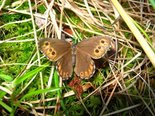
Jutta Arctic - Oeneis jutta
Status in Nova Scotia
Uncommon and very local. There are historical records from Mount Uniacke and Cape Breton; recent records are from Cumberland, Guysborough and Richmond counties. The Maritimes Butterfly Atlas S-rank for this species is "S3: Uncommon, or found only in a restricted range, even if abundant at some locations (21 to 100 occurrences)."
Flight Period
Mid-May to late June.
Habitat
Tamarack and Black Spruce bogs.
Larval Foodplants
Sedges such as Cotton-grass (Eriophorum sp.), and Carex.
Similar Species in Nova Scotia
None.
Notes
Until recently, this species was known as Balder's Arctic, Oeneis balderi.
Uncommon and very local. There are historical records from Mount Uniacke and Cape Breton; recent records are from Cumberland, Guysborough and Richmond counties. The Maritimes Butterfly Atlas S-rank for this species is "S3: Uncommon, or found only in a restricted range, even if abundant at some locations (21 to 100 occurrences)."
Flight Period
Mid-May to late June.
Habitat
Tamarack and Black Spruce bogs.
Larval Foodplants
Sedges such as Cotton-grass (Eriophorum sp.), and Carex.
Similar Species in Nova Scotia
None.
Notes
Until recently, this species was known as Balder's Arctic, Oeneis balderi.
This species has a two-year life-cycle: the larva passes its first winter as a first or second instar, and its second winter as a fourth or fifth instar.
It has been found in successive years in a Guysborough County bog (2011 and 2012), so these might almost be considered two independent populations of one species living in the same place at the same time.
Further Reading
- eButterfly.org: Nova Scotia records, Canada records
- iNaturalist.org: 12 Nova Scotia records, 832 North America records
- The Butterflies of Canada
|



![Jutta Arctic - Apple River, NS - 2010-05-25 [Jutta Arctic image]](img/010279tl.jpg)

